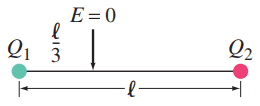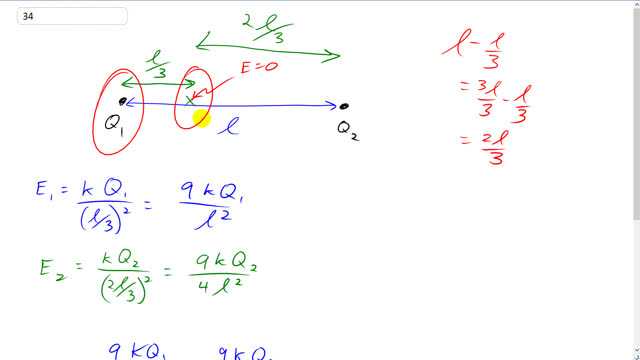
You are given two unknown point charges, and . At a point on the line joining them, one-third of the way from to , the electric field is zero (Fig. 16–59). What is the ratio ?


In order to watch this solution you need to have a subscription.
This is Giancoli Answers with Mr. Dychko. We have some unknown charges Q one and Q two here and we know this position here’s one-third of the total distance between them from the left charge has an electric field of zero. So the distance between Q one and this point of interest is l over three, l being the total distance between them which means the distance from Q two to that same position is the total distance l minus l over three which is three l over three when you multiply this by three over three and which is two l over three and then we say that electric field due to charge one is gonna equal the electric field due to charge two because since there is no electric field there, the magnitude of the two electric fields must be the same in opposite directions. So the magnitude of electric field one is k Q one divided by the distance squared which is l over three squared which makes nine k Q one over l squared and you can multiply top and bottom by three squared here and three squared cancel there and end up with three squared in the top which is 9 and then E two is k Q two over two l over three squared which makes nine k Q two over four l squared and these two are equal to each other and equal magnitude anyhow. So we have 9 k Q one over l squared equals 9 k Q two over 4 l squared and then the nine k l squared cancel on both sides and we're left with… after we multiply both sides by one over Q two, we end up with the ratio of the charges, Q one over Q two is one quarter. So, Q one is a quarter of what Q two is and it makes sense that Q one is less because in order for these electric fields to cancel given that this point is so much closer to Q one, Q one is going to have to have a much less charge in order to have the same electric field strength as this one does this ones have, gonna have to have a bigger charge since this point is further away from it than it is from Q one.